Pools can turn green for several reasons, and if this happens to you, shocking the water is the most effective way to turn the water blue again. But, sometimes, the water stays green after shocking. Let’s look at some reasons your pool is still green after shocking.
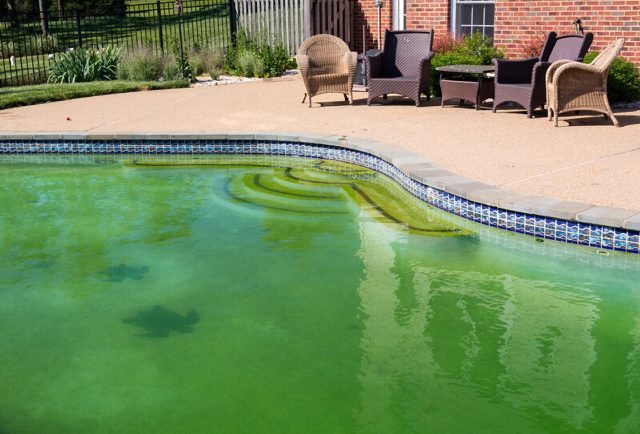
Article Contents
Reason 1: Weak Shock Treatment
You may not have used enough shock, or the shock expired. The correct dose is 1 pound of granulated shock or 1 ½ gallons of liquid shock per 10,000 gallons of water. You can double or triple the dose if you have a severe algae issue.
Sometimes a pool has to be shocked multiple times before it clears up. Clear up a green pool can take up to a week, so be patient. If you have used fresh shock multiple times and the pool is still green after a week, you may need to call a professional.
Cal-hypo shock is the most common and powerful on the market. It’s also unstabilized, which means UV rays will dissolve it quickly. It also won’t affect the cyanuric acid levels. Because of this, ensure that your stabilizer (cyanuric acid) levels are 30-50 ppm, and you add the shock at night when the sun has set. You can get this advanced pool shock product here:
- Fast-dissolving
- Kills bacteria and algae
- Reduces chlorine odor and irritation
Reason 2: Metals In The Water
We covered this topic in a previous article, but here is a summary. If your pool is green and you don’t have algae, the most likely reason is that there is a high level of metals in your pool, particularly copper. This generally happens after filling the pool, as most tap water has high metal content.
When chlorine is introduced to copper or other metals, the metals oxidize and turn the water green. This is common with well water or metal-based algaecide. If your pool is still green after shocking, take a sample of the pool water to be tested for metals. Add liquid metal control to clear up the water if the level is high.
Reason 3: Poor Water Circulation
Poor water circulation could be why your pool turned green in the first place. Stagnant water is a breeding ground for algae, and if your water isn’t circulating properly, the filtration system won’t be able to filter out harmful bacteria and other debris.
Circulation is also important when you add shock because the shock needs to be evenly distributed around the pool and into the plumbing to work effectively. Poor water circulation could be caused by a dirty skimmer or pump baskets, a clogged filter, or a warped pump basket O-ring.
Not running the pump long enough also causes this. Pumps should be run about 8-12 hours a day under normal conditions and 24/7 when shocking the pool.
Reason 4: Incorrect pH or Stabilizer Levels
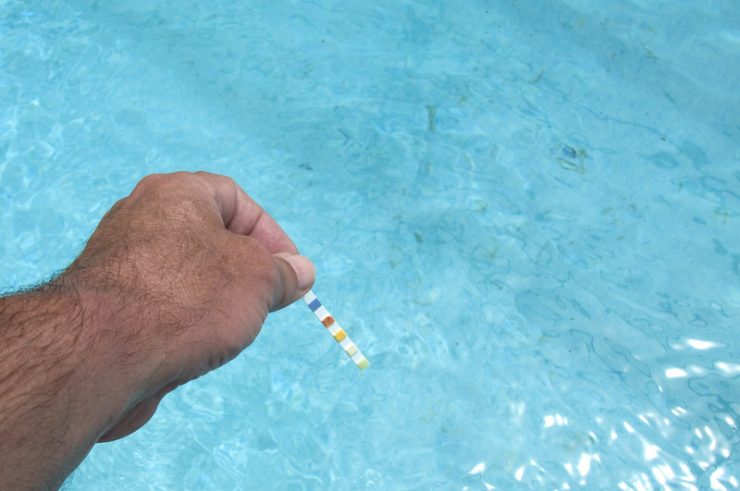
Before you shock your pool, the pH must be between 7.2 and 7.6 for the shock to be effective. If the pH is too high or low, the shock won’t work properly, which is probably why your pool is still green.
Always test your water chemistry before adding shock or algaecide. If you have to adjust the pH, be patient and wait two hours before adding the shock and algaecide to give the pH levels time to adjust.
Too much stabilizer (cyanuric acid) or insufficient stabilizer will also reduce the effectiveness of chlorine. If the stabilizer is low, below 10 ppm, the sun can destroy a lot of it before it has a chance to work. And if the stabilizer is high, about 80 ppm, then chlorine is less effective.
Reason 5: Copper-Based Algaecide
Algaecides are powerful chemicals specifically designed to eliminate algae. Follow the dosing instructions so you don’t overdose on the pool. Adding too much will cause an odor and foaming, and, in the case of metal-based algaecides, it can cause staining.
As mentioned above, copper-based algaecides can oxidize with chlorine and cause your water to turn green. If so, add a liquid metal control to clear up the water.
Reason 6: Flocculant or Clarifier Wasn’t Used During Algae Treatment
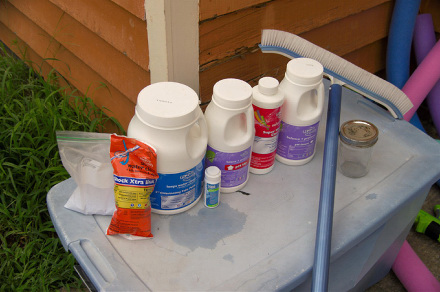
If you cannot see the bottom of your pool after shocking due to cloudiness, you will need to add a clarifier or flocculant to your pool. Clarifiers add brightness to the pool by attaching microparticles to larger particles removed by the filtration system. Flocculants bind larger particles like algae dust or debris and make them sink to the bottom of the pool, which will then need to be vacuumed for removal.
Reason 7: High Phosphates
Algae feed off of phosphates; if your levels are too high, you may not be able to get rid of the algae, even after shocking. If you’re having difficulty eliminating the algae issue, bring a sample of your pool water to a reputable pool store to test for phosphates. If they’re high, use a liquid phosphate decreaser to bring the phosphates below 500 ppb.
Reason 8: Pool Wasn’t Brushed Properly
Brushing the pool walls, steps, and ledges is critical to algae removal. The pool should be brushed before applying shock, or the shock cannot attack the algae. If the walls were not thoroughly brushed before applying shock to the pool, the algae aren’t dead.
You should use a metal brush for concrete and plaster finishes or a nylon brush for liners or fiberglass pools. Clean the filter before you brush so that the algae can be filtered out. You will have to brush aggressively and in overlapping strokes to ensure you cover the entire pool surface.
Reason 9: Pool Wasn’t Vacuumed Properly
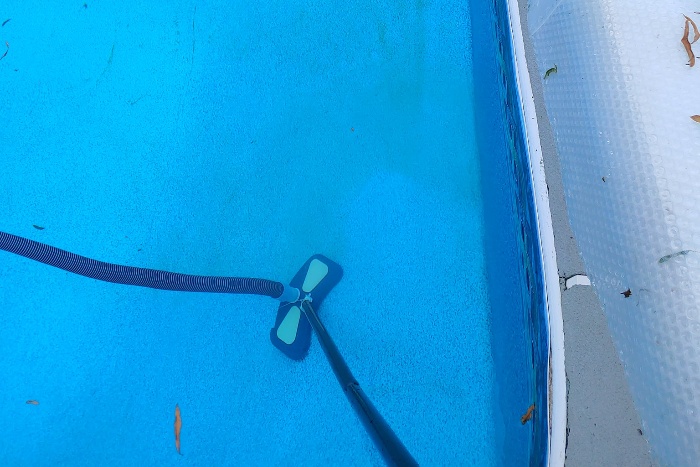
After you have treated the pool with shock and algaecide and thoroughly brushed away any algae particles, dead or alive, they need to be immediately removed by vacuuming. If not, the pool will be cloudy at best, or the algae will grow back at worst. As with brushing, vacuum in overlapping strokes methodically, and don’t forget to brush all ledges and steps.
Reason 10: The Filter Wasn’t Run Long Enough
You should run your filtration system for 24-48 hours to eliminate algae. Many people forget this step and only run the filter for 6 or 8 hours because that’s how long the algaecide takes to work. The filtration system needs at least 24 hours to filter algae dust and bacteria.
The filter needs to be cleaned or back washed before algaecide and shock are used. A clogged filter will not be able to absorb the algae, and it will remain in the pool. If you have a particularly bad algae issue, you should clean the filter every 12 hours (sometimes more) to ensure it doesn’t clog.
Tips to Clear a Green Pool After Shocking
Algae is the number one reason a pool turns green, and the main cause is usually a chemical imbalance. You can do several things to turn your water blue again after shocking.
Just adding pool shock is not enough to clear a green pool. You must also brush, vacuum, and clean the filters periodically to remove the green, particularly dead algae. Here are a few helpful tips to turn your green pool blue again.
Brush the pool walls and floor
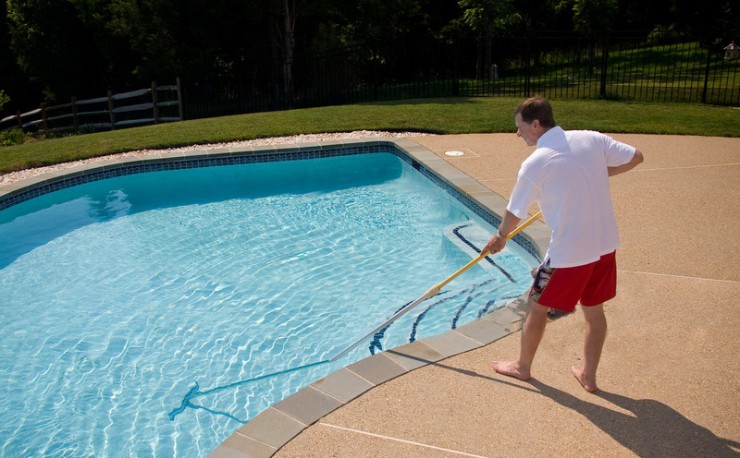
Brushing the walls and floor toward the drain will help the filtration system cycle out any debris or algae dust. Brushing the walls will also eliminate algae growing in crevices and pores. Ensure the system is running when you brush the pool so that any debris can cycle out.
Run the pump for 24-48 hours
Run the pump for at least 24 hours and make sure the filter is clean. Running the pump will help distribute the algaecide and shock throughout the pool and the plumbing system and cycle any bacteria, algae, or debris to the filter. If the filter is clogged, the debris will cycle back into the poo, so be sure to clean it.
Test the alkalinity, stabilizer, and pH levels
Start by testing the alkalinity; it should be between 100-150 ppm. If you have to adjust it, this could balance the pH. After your alkalinity is in range, test and adjust the pH level between 7.2-7.6 ppm.
You’ll also need to test the stabilizer (cya or cyanuric acid). Ideally, it should be 30-50 ppm. But 10 ppm and up to 80 ppm are acceptable.
Use flocculant
If your pool is still green due to algae dust, flocculant will help you filter the debris. Flocculant is a chemical that clumps together particles, making them heavy enough to sink to the bottom of the pool so you can vacuum them out. I have done this before, and it made vacuuming much easier. You’ll need to clean your filter out after doing this, as floc can clog filters.
Here’s a flocculant we can recommend:
- Swiftly clears up cloudy pool water by coagulating and sinking particles
- Removes silt, dead algae, organic matter, oils, and lotions
- Works in 8-12 hours
Final Thoughts
It’s not uncommon for a pool to still be green after shocking it. There are several causes, and troubleshooting the root cause isn’t too hard if you know what to look for. A green pool should clear up within a few days with the correct treatment.



